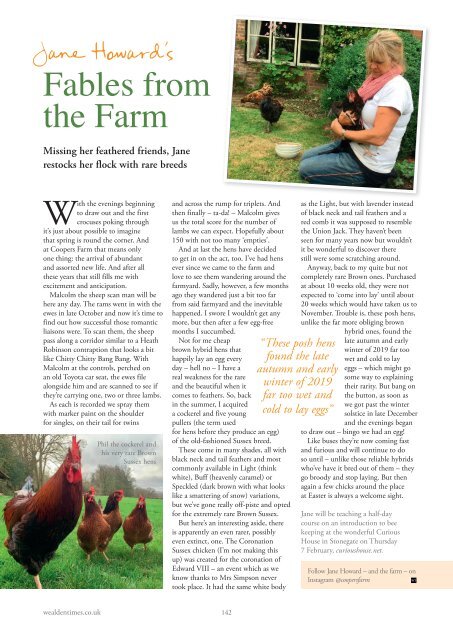Wealden Times | WT216 | February 2020 | Interiors supplement inside
Wealden Times - The lifestyle magazine for the Weald
Wealden Times - The lifestyle magazine for the Weald
Create successful ePaper yourself
Turn your PDF publications into a flip-book with our unique Google optimized e-Paper software.
Jane Howard’s<br />
Fables from<br />
the Farm<br />
Missing her feathered friends, Jane<br />
restocks her flock with rare breeds<br />
With the evenings beginning<br />
to draw out and the first<br />
crocuses poking through<br />
it’s just about possible to imagine<br />
that spring is round the corner. And<br />
at Coopers Farm that means only<br />
one thing: the arrival of abundant<br />
and assorted new life. And after all<br />
these years that still fills me with<br />
excitement and anticipation.<br />
Malcolm the sheep scan man will be<br />
here any day. The rams went in with the<br />
ewes in late October and now it’s time to<br />
find out how successful those romantic<br />
liaisons were. To scan them, the sheep<br />
pass along a corridor similar to a Heath<br />
Robinson contraption that looks a bit<br />
like Chitty Chitty Bang Bang. With<br />
Malcolm at the controls, perched on<br />
an old Toyota car seat, the ewes file<br />
alongside him and are scanned to see if<br />
they’re carrying one, two or three lambs.<br />
As each is recorded we spray them<br />
with marker paint on the shoulder<br />
for singles, on their tail for twins<br />
Phil the cockerel and<br />
his very rare Brown<br />
Sussex hens<br />
and across the rump for triplets. And<br />
then finally – ta-da! – Malcolm gives<br />
us the total score for the number of<br />
lambs we can expect. Hopefully about<br />
150 with not too many ‘empties’.<br />
And at last the hens have decided<br />
to get in on the act, too. I’ve had hens<br />
ever since we came to the farm and<br />
love to see them wandering around the<br />
farmyard. Sadly, however, a few months<br />
ago they wandered just a bit too far<br />
from said farmyard and the inevitable<br />
happened. I swore I wouldn’t get any<br />
more, but then after a few egg-free<br />
months I succumbed.<br />
Not for me cheap<br />
brown hybrid hens that<br />
happily lay an egg every<br />
day – hell no – I have a<br />
real weakness for the rare<br />
and the beautiful when it<br />
comes to feathers. So, back<br />
in the summer, I acquired<br />
a cockerel and five young<br />
pullets (the term used<br />
for hens before they produce an egg)<br />
of the old-fashioned Sussex breed.<br />
These come in many shades, all with<br />
black neck and tail feathers and most<br />
commonly available in Light (think<br />
white), Buff (heavenly caramel) or<br />
Speckled (dark brown with what looks<br />
like a smattering of snow) variations,<br />
but we’ve gone really off-piste and opted<br />
for the extremely rare Brown Sussex.<br />
But here’s an interesting aside, there<br />
is apparently an even rarer, possibly<br />
even extinct, one. The Coronation<br />
Sussex chicken (I’m not making this<br />
up) was created for the coronation of<br />
Edward VIII – an event which as we<br />
know thanks to Mrs Simpson never<br />
took place. It had the same white body<br />
“These posh hens<br />
found the late<br />
autumn and early<br />
winter of 2019<br />
far too wet and<br />
cold to lay eggs”<br />
as the Light, but with lavender instead<br />
of black neck and tail feathers and a<br />
red comb it was supposed to resemble<br />
the Union Jack. They haven’t been<br />
seen for many years now but wouldn’t<br />
it be wonderful to discover there<br />
still were some scratching around.<br />
Anyway, back to my quite but not<br />
completely rare Brown ones. Purchased<br />
at about 10 weeks old, they were not<br />
expected to ‘come into lay’ until about<br />
20 weeks which would have taken us to<br />
November. Trouble is, these posh hens,<br />
unlike the far more obliging brown<br />
hybrid ones, found the<br />
late autumn and early<br />
winter of 2019 far too<br />
wet and cold to lay<br />
eggs – which might go<br />
some way to explaining<br />
their rarity. But bang on<br />
the button, as soon as<br />
we got past the winter<br />
solstice in late December<br />
and the evenings began<br />
to draw out – bingo we had an egg!<br />
Like buses they’re now coming fast<br />
and furious and will continue to do<br />
so until – unlike those reliable hybrids<br />
who’ve have it bred out of them – they<br />
go broody and stop laying. But then<br />
again a few chicks around the place<br />
at Easter is always a welcome sight.<br />
Jane will be teaching a half-day<br />
course on an introduction to bee<br />
keeping at the wonderful Curious<br />
House in Stonegate on Thursday<br />
7 <strong>February</strong>, curioushouse.net.<br />
Follow Jane Howard – and the farm – on<br />
Instagram @coopersfarm<br />
wealdentimes.co.uk<br />
142


















